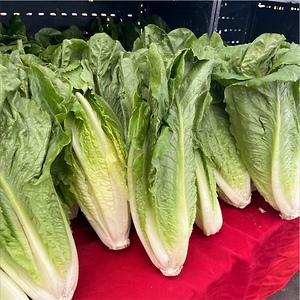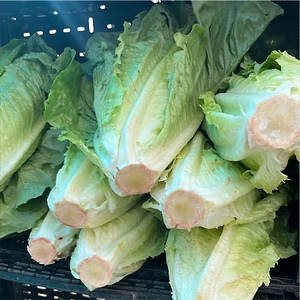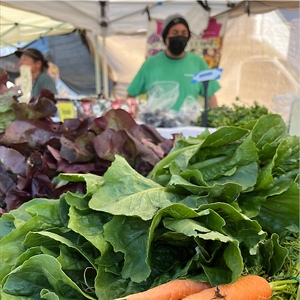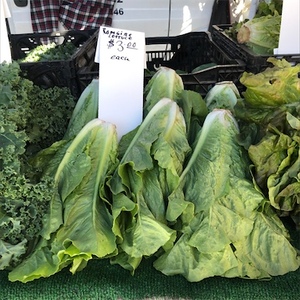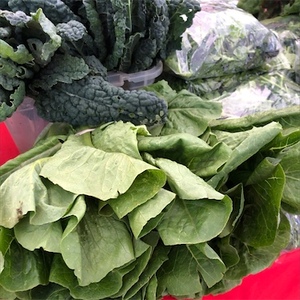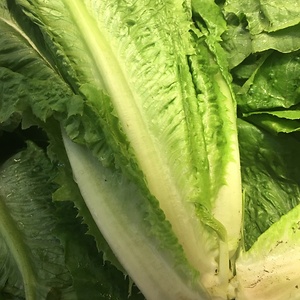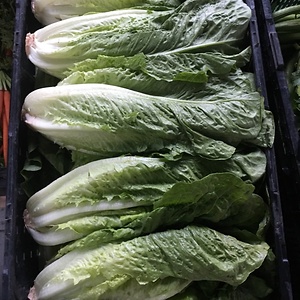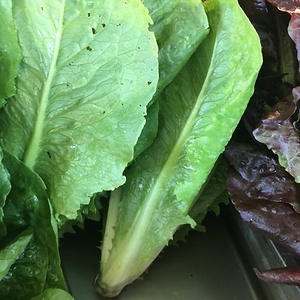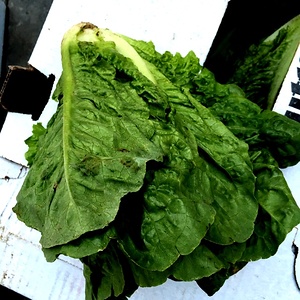

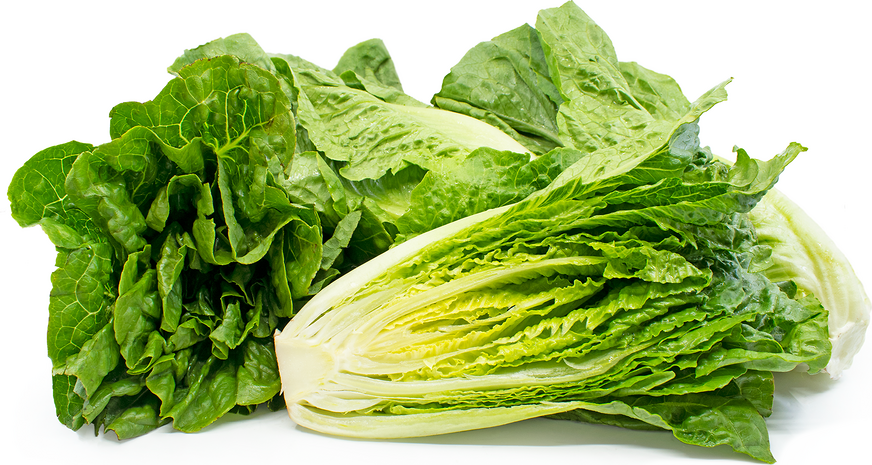
Romaine Lettuce
Estimated Inventory, 24 ct : 112.59
This item was last sold on : 08/02/25
Description/Taste
Romaine lettuce is medium to large in size with an elongated shape and stiff, upright leaves. The thick heads are loosely connected to a central blanched base and the leaves, averaging 10-15 centimeters in length, are broad with many folds and creases. The outer leaves are dark green with a prominent white central rib, and as the leaves grow smaller in the center, they become paler in color almost fading to white. Romaine lettuce is crisp, succulent, and crunchy with a mild, slightly bitter taste.
Seasons/Availability
Romaine lettuce is available year-round, with a peak season in the winter.
Current Facts
Romaine lettuce, botanically classified as Lactuca sativa, is believed to be one of the oldest varieties of lettuce in the world and is a member of the Asteraceae family. Also known as Cos lettuce in England, Lattuga Romana in Italian, and Laitue Romaine in French, Romaine lettuce is one of the few varieties that grow upright, is tolerant of heat, and is commonly sold in whole heads or as hearts, which means the outer leaves are removed leaving only the tender, pale inner leaves. Romaine lettuce has been used by civilizations for thousands of years and is still popular worldwide, favored for its mild taste, firm stalks, and crunchy texture.
Nutritional Value
Romaine lettuce an excellent source of dietary fiber, vitamins A, C, and K, thiamin, folate, iron, potassium, and manganese. It is also a good source of riboflavin, vitamin B6, calcium, magnesium, phosphorus, and copper.
Applications
Romaine lettuce is best suited for both raw and cooked applications such as braising, grilling, and lightly boiling. The leaves can be used fresh and torn for salads, or they can be used as a dipping vessel for sauces, dips, and fillings. They can also be layered on sandwiches, burgers, and in wraps for added crunch. In addition to fresh preparations, Romaine lettuce can withstand high heat which makes it suitable for grilling, braising with cooked vegetables and meat, adding to soups, and chopping and mixing into stir-fries. Romaine lettuce pairs well with bulgur wheat, parsley, garlic, chives, tomatoes, roasted red pepper, citrus, avocado, apples, pears, black olives, capers, grilled steak, poultry, bacon, tuna, smoked fish, feta cheese, blue cheese, parmesan cheese, and hummus. The leaves will keep up to one week when wrapped in paper towels to absorb excess moisture and stored in the crisper drawer of the refrigerator.
Ethnic/Cultural Info
Romaine lettuce has been used in cultures all over the world in both culinary and medicinal applications. In Egypt, there are ancient paintings on tomb walls that depict lettuce with pointed, elongated leaves and many experts believe it is a variety of Romaine. The lettuce was also served to Persian kings and used as an edible spoon for dips and spreads like tabbouleh in Syria. In addition to culinary use, in Rome, the milky liquid produced from the outer leaves was believed to have restorative properties and was used by many ancient healers to reduce symptoms of diseases and illness. Today Romaine is still a widely used variety and is most well-known for its use in the Caesar salad.
Geography/History
Romaine lettuce is native to the Mediterranean and the Middle East, growing since ancient times, and its two most recognizable names are derived from the papal gardens in Rome and the Aegean Islands of Cos. Originally considered a weed in the Mediterranean, Romaine lettuce is documented as being one of the oldest known cultivated varieties, having been grown for at least 5,000 years. Today Romaine lettuce is widely found at supermarkets, farmers markets, and specialty grocers in Asia, Europe, Australia, Africa, North America, and South America.
Featured Restaurants
Restaurants currently purchasing this product as an ingredient for their menu.
| Bayhill Tavern | San Diego CA | 858-288-6923 |
| Crust & Brew | San Diego CA | 858-212-8751 |
| The Privateer Coal Fire Pizza | Oceanside CA | 760-310-1535 |
| Brockton Villa Restaurant | San Diego CA | 858-454-7393 |
| Hash House A Go Go | San Diego CA | 951-764-0605 |
| Nolita Hall | San Diego CA | 619-618-8820 |
| Single Fin Surf Grill | San Diego CA | 619-948-7873 |
| Revolution Roasters (Carlsbad) | Carlsbad CA | 760-330-6827 |
| WaterBar | San Diego CA | 619-308-6500 |
| Firefly Beach | San Diego CA | 619-222-6440 |
| Burgo Direct | Chula Vista CA | 619-793-2325 |
| Brigantine Poway | Poway CA | 858-486-3066 |
| Il Sogno Italiano | San Diego CA | 619-380-2652 |
| Nunu's Tavern | San Diego CA | 619-756-4009 |
| Crest Cafe | San Diego CA | 619-295-2510 |
| Milton's Delicatessen, Grill & Bakery | Del Mar CA | 858-792-2225 |
| Portside Pier (Brigantine) | San Diego CA | 858-268-1030 |
| The Crack Shack-Encinitas | Encinitas CA | 877-230-1871 |
| Daffodil Cafe | San Diego CA | 858-461-7788 |
| Harley Gray Kitchen and Bar | San Diego CA | 619-840-7000 |
| Q&A Oyster Bar & Restaurant | Oceanside CA | 858-245-3780 |
| Nadolife Production | San Diego CA | 619-239-1224 |
| Village Pizzeria Bay Side | Coronado CA | 619-522-6890 |
| Wolf In the Woods | San Diego CA | 619-851-7275 |
| Crafted @ Minerva's Cafe | La Jolla CA | 858-699-4129 |
| The Market by Buon Appetito | San Diego CA | 619-237-1335 |
| Lil Piggy's | Coronado CA | 619-522-6890 |
| Belching Beaver Brewery - Pub 980 | Vista CA | 760-420-7764 |
| KI's | Encinitas CA | 760-586-8289 |
| Tavern at the Beach | San Diego CA | 858-272-6066 |
| Peace Pies | San Diego CA | 619-618-6960 |
| UCSD Food & Nutrition Department La Jolla | San Diego CA | 858-761-1269 |
| Miguel's Cocina Coronado | Coronado CA | 619-437-4237 |
| Elks Lodge 2698 -Donation | Lakeside CA | 619-390-4949 |
| Glenbrook Health Center | Carlsbad CA | 760-704-1000 |
| Urban Kitchen Catering | San Diego CA | 619-276-8803 |
| Roppongi (IB) | Imperial Beach CA | 858-456-8018 |
| Marriott Coronado | Coronado CA | 619-435-3000 x6335 |
| AC Hotel by Marriott SD | San Diego CA | 248-703-3310 |
| Revolution Roasters | Oceanside CA | 760-330-6827 |
| Brigantine Escondido | Escondido CA | 760-743-4718 |
| Portside Pier (Ketch Tasting Deck) | San Diego CA | 858-268-1030 |
| Vitality Tap - 1St Ave | San Diego CA | 619-237-7625 |
| Ulivo | San Diego CA | 619-962-7345 |
| Moxy San Diego Gaslamp | San Diego CA | 619-376-1850 |
| Village Pizzaria | Coronado CA | 619-522-6890 |
| The Plot | Oceanside CA | 422-266-8200 |
| Sabi Juice | Chula Vista CA | 619-971-8545 |
| Viejas Casino Grove Steakhouse | Alpine CA | 800-295-3172 |
| Jack & Giulio's | San Diego CA | 619-294-2074 |
| Green Acres Campus | San Diego CA | 858-450-9907 |
| Turf Supper Club | San Diego CA | 619-234-6363 |
| The Local-Pacific Beach | San Diego CA | 858-263-7475 |
| Belching Beaver Brewery Tavern and Grill | Vista CA | 760-509-4424 |
| The Crack Shack PB | San Diego CA | 619-450-7978 |
| Beaumont's | San Diego CA | 858-459-0474 |
| Uptown Tavern | San Diego CA | 619-683-9322 |
| Trattoria I Trulli | Encinitas CA | 760-277-9826 |
| Juniper & Ivy | San Diego CA | 858-481-3666 |
| Blue Whale | La Jolla CA | 808-868-8639 |
| Kensington Cafe | San Diego CA | 619-684-0044 Fausto |
| Bayside Landing | San Diego CA | 858-270-9200 |
| Eddie V's La Jolla - EV# 8511 | La Jolla CA | 858-459-5500 |
| Brigantine Coronado | Coronado CA | 619-435-4166 |
| Chateau La Jolla | San Diego CA | 858-459-4451 |
| Duke's La Jolla | La Jolla CA | 858-454-1999 |
| Storyhouse Spirits Bar | San Diego CA | 801-949-5955 |
| Sushi Kami | San Diego CA | 858-451-7799 |
| Leucadia Pizza Scripps Ranch | San Diego CA | 858-530-2222 |
| Margaritaville Hotel SD (Kitchen) | San Diego CA | 619-819-9500 |
| The Monsaraz | San Diego CA | 858-760-6228 |
| Saint Mark Golf and Resort, LLC | San Marcos CA | 508-320-6644 |
| Crust Pizzeria Solana Beach | Solana Beach CA | 858-212-8751 |
| Marriott Courtyard Old Town | San Diego CA | 619-260-8500 |
| Casero Taqueria | Carlsbad CA | 760-533-4997 |
| Miguel's Cocina Carlsbad | Carlsbad CA | 760-759-1843 |
| Slowly | San Diego CA | 858-352-6080 |
| Brigantine La Mesa | La Mesa CA | 619-465-1935 |
| Urbn Pizza Kitchen | San Diego CA | 619-255-7300 |
| Espadin | Temecula California | 951-383-5585 |
| RoVino Rotisserie + Wine | San Diego CA | 619-972-6286 |
| Brigantine Del Mar | Del Mar CA | 858-481-1166 |
| Hilton La Jolla Torrey Pines | La Jolla CA | 858-450-4581 |
| Great Maple Hillcrest | San Diego CA | 619-255-2282 |
| Miguel's 4S Ranch | San Diego CA | 858-924-9200 |
| The Hop Stop | Poway CA | 858-859-2669 |
| San Diego Freedom Ranch | Campo CA | 619-478-5696 |
| Shogun Sportfishing | San Diego CA | 619-226-8030 |
| Manhattan of La Jolla | La Jolla CA | 858-459-0700 |
| Oscars Brewing Company | Temecula CA | 619-695-2422 |
| Bread & Cie Café | San Diego CA | 619-683-9322 |
| Third Corner Ocean Beach | San Diego CA | 619-223-2700 |
| Casa | San Diego CA | 619-581-3003 |
| Cardellino | San Diego CA | 619-722-3398 |
| Higher Grounds Coffee + Cafe | San Diego CA | 831-247-5395 |
| Searcher Sportfishing | San Diego CA | 619-861-4640 |
| Vagabond Sportfishing Inc. | San Diego CA | 619-993-9575 |
| Pitchers | San Diego CA | 858-472-1251 |
| Belmont Park Draft | San Diego CA | 858-228-9283 |
| The Crack Shack-San Diego | San Diego CA | 619-795-3299 |
| The Shout House | San Diego CA | 619-231-6700 |
| Pacific Coast Grill | Solana Beach CA | 858-794-4632 |
| Tap Room Beer Co. | San Diego CA | 619-539-7738 |
| Barefoot Coffee Cafe | Solana Beach CA | 858-209-2179 |
| MCRD-Marine Corps Recruit Dept | San Diego CA | 619-725-6478 |
| Brigantine Pt Loma | San Diego CA | 619-224-2871 |
| Olive Tree Marketplace | San Diego CA | 619-224-0443 |
| Bar Ella | San Diego CA | 858-808-2286 |
| Cocina de Barrio Point Loma | San Diego CA | 858-349-2313 |
| La Jolla Country Club | San Diego CA | 858-454-9601 |
| Royal Polaris Sportfishing | San Diego CA | 619-226-8030 |
| Knotty Barrel- Rancho | San Diego CA | 858-484-8758 |
| The Lab Restaurant | Oceanside CA | 619-861-8299 |
| Sonny's Pizza | San Diego CA | 619-432-1838 |
| Coronado Yacht Club | Coronado CA | 619-435-1848 |
| Richard Walkers Pancake House (LJ) | La Jolla CA | 858-459-8800 |
| The Whaling Bar | La Jolla CA | 858-355-9218 |
| The Crack Shack Costa Mesa | Costa Mesa CA | 951-808-7790 |
| The Switchboard Restaurant 2024 | Oceanside CA | 760-279-6300 |
| Bali Hai Restaurant | San Diego CA | 619-222-1181 |
| Sisters Pizza | San Diego CA | 858-228-6822 |
| The Morning Grove | Carlsbad CA | 7605000465 |
| The Shores | La Jolla CA | 858-459-8271 |
| Pacific Terrace Hotel | San Diego CA | 858-581-3500 |
| Pacific Cafe & Catering (Medical Cntr Dr.) | La Jolla CA | 619-808-4087 |
| Terra Restaurant | San Diego CA | 619-293-7088 |
| Leucadia Pizza Point Loma | San Diego CA | 619-295-2222 |
| Shoreside Support Boat | San Diego CA | 704-277-7929 |
| Upper East | Escondido CA | 619-787-1617 |
| Little Italy Pizzeria and Pasta | San Diego CA | 619-220-0025 |
| Bahia Resort Hotel | San Diego CA | 858-488-0551 |
| Brigantine Imperial Beach | Imperial Beach CA | 619-591-1350 |
| JRDN Restaurant | San Diego CA | 858-270-5736 |
| Lodge at Torrey Pines Grill | San Diego CA | 858-453-4420 |
| Sensations Salud | San Diego CA | 619-933-3489 |
| The Original 40 Brewing | San Diego CA | 619-206-4725 |
| Mavericks Beach Club | San Diego CA | 858-999-0348 |
| Joya Kitchen | San Diego CA | 619-255-5979 |
| Sisters Pizza (NP) | San Diego CA | 858-228-6822 |
| Tavola Nostra Pizzeria E Cucina | San Diego CA | 619-921-4206 |
| The Haven (Pizzeria) | San Diego CA | 619-964-3778 |
| Polaris Supreme | San Diego CA | 619-390-7890 |
| Whiskey Girl | San Diego CA | 619-236-1616 |
| Jake's Del Mar | Del Mar CA | 858-755-2002 |
| UCSD Food & Nutrition Department Hillcrest | San Diego CA | 619-380-9840 |
| Living Coast Discovery Center | Chula Vista CA | 619-409-5900 |
| Prager Brothers Artisan Bread | Carlsbad CA | 760-445-9536 |
| Blue Ocean Sushi & Grill (UTC) | San Diego CA | 858-886-9909 |
| Ballast Point Rest. - Miramar | San Diego CA | 858-790-6900 |
| Junkyard Sports Bar and Grill | Oceanside CA | 760-407-8500 |
| Fay's Diner and Cafe | San Diego CA | 661-858-8895 |
Recipe Ideas
Recipes that include Romaine Lettuce. One



